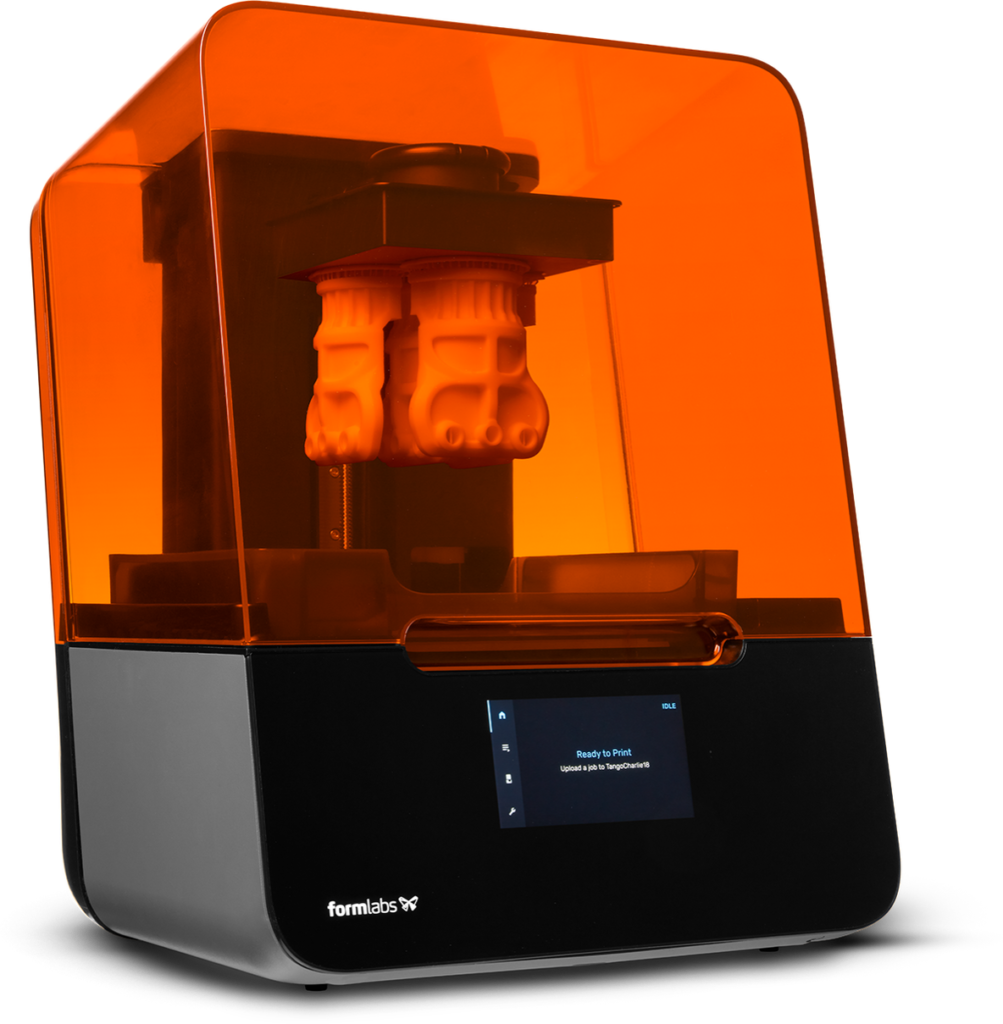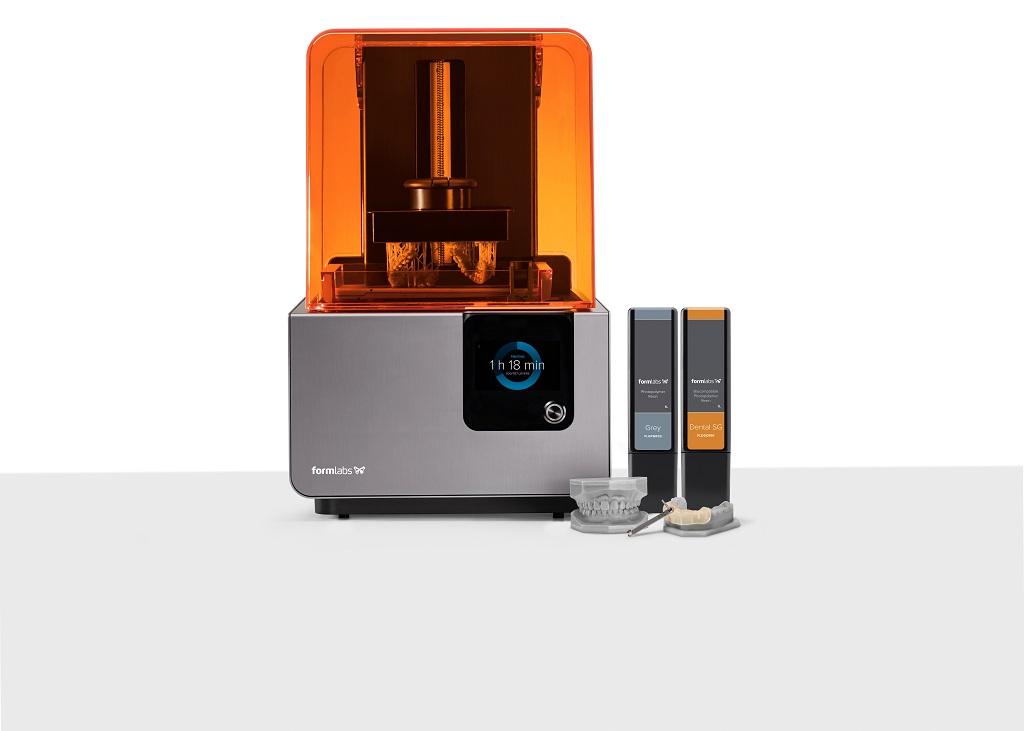At CES 2021, 3D printing company Formlabs announced the release of a new material, Castable Wax 40 Resin. The material, for designers and manufacturers of jewelry, is addition number 30 in the Formlabs material library.
The fact that Castable Wax 40 Resin is the 12th new material added to the Formlabs material library in the past year highlights the company’s investment strategy for the long term: material research may be more valuable than hardware research.
 The Form 3, Form 3B, Form 3L, and Form 3BL from Formlabs are powered by an advanced form of stereolithography (SLA) called Low Force Stereolithography (LFS). (Image courtesy of Formlabs.)
The Form 3, Form 3B, Form 3L, and Form 3BL from Formlabs are powered by an advanced form of stereolithography (SLA) called Low Force Stereolithography (LFS). (Image courtesy of Formlabs.)Formlabs is creating new materials for designers and manufacturers in the jewelry industry. Jewelry is a valued commodity for a number of reasons. As a purchase for consumers, jewelry is a highly personal, emotionally driven aesthetic choice that represents beauty, charm, magic, and personal expression. Since the dawn of time, jewelry has reflected and symbolized wealth, family, and love, as well as vainglory and social status.
The company is wisely investing in resin development because powerful software can help materials researchers innovate at a higher pace than would be possible with the same amount of capital applied to hardware research. Their is more bang in every buck Formlabs invests in materials research versus hardware research. Hardware develops at a snail’s pace, and their isn’t that much room for innovation.
Given the type of technology used in Formlabs flagship printers, it makes sense that they would want to innovate by creating new materials in the spectrum of UV sensitive photopolymer materials for industrial manufacturing in a number of areas. However, Formlabs also used their capital investment in material research to quickly produce biocompatible materials such as those used to 3D print COVID-19 test swabs early on in the 2020 pandemic. Formlabs essentially displayed what makes them unique: the ability to target and hit research goals for new materials. Their flexible and agile research and development as well as production stand in contraposition to the mechanisms of global supply chains, which revealed their fragile nature as they collapsed under the strain of the coronavirus.
 Dental SG biocompatible material for dentistry was released in 2016. (image courtesy of Formlabs.)
Dental SG biocompatible material for dentistry was released in 2016. (image courtesy of Formlabs.)Flexibility is an important part of material design and research at Formlabs. Investing in biocompatible resins means paying attention to different medical market supply and demand. Formlabs released six new biocompatible resins for 3D printing applications in the dental industry.
Some jewelry takes the form of grills for your teeth. Perhaps biocompatible resin would be interesting for jewelry designers who design grills.
But, mostly, the Castable Wax 40 Resin is for jewelers schooled in traditional manufacturing methods, such as lost wax casting. Typically, jewelry designers use something called blue carving wax to create molds with different shapes for jewelry designs. Formlabs claims to have succeeded in replicating the material properties of blue carving wax.
The real point of interest for jewelry designers and manufacturers considering switching from traditional lost wax casting to 3D printing is digitization. For some, digitization of manufacturing means a dip in quality. Aesthetes of different persuasion will convince you that making things by hand allows for subtlety and nuance necessary to achieve artistic expression. But not every jeweler is an artist, and not every artist looks down on new technology when considering innovative ways to tweak their process.
Castable Wax 40 Resin provides jewelers a material with 40 percent wax material in it, but the 3D workflow (once skilled at 3D modeling, which can take some time or outsourcing capital) is potentially game-changing in terms of efficiency and even artistic expression.
GIA is a world-renowned authority on precious stones and gems like diamonds and pearls. Rio Grande is a well-known authority on jewelry, and well as the tools and equipment needed to design and manufacture world-class jewelry.
Kathy Bui, Formlabs Engineering Vertical Lead, commented on the process, saying, “Resins can be soft and stretchy, tough and sturdy, strong and rigid and they can also be biocompatible, and FDA approved to be in contact with the skin or mucous membranes. New materials unlock new applications, from everyday products like a pair of shoes used in a marathon to medical devices and surgical guides that assist in the operating room.”
 Castable Wax 40 Resin is available right now for jewelry designers and manufacturers using the company’s SLA 3D printers.
Castable Wax 40 Resin is available right now for jewelry designers and manufacturers using the company’s SLA 3D printers.
Subscribe to Our Email Newsletter
Stay up-to-date on all the latest news from the 3D printing industry and receive information and offers from third party vendors.
You May Also Like
Precision at the Microscale: UK Researchers Advance Medical Devices with BMF’s 3D Printing Tech
University of Nottingham researchers are using Boston Micro Fabrication‘s (BMF) 3D printing technology to develop medical devices that improve compatibility with human tissue. Funded by a UK grant, this project...
3D Printing Webinar and Event Roundup: April 21, 2024
It’s another busy week of webinars and events, starting with Hannover Messe in Germany and continuing with Metalcasting Congress, Chinaplas, TechBlick’s Innovation Festival, and more. Stratasys continues its advanced training...
3D Printing Webinar and Event Roundup: March 17, 2024
It’s another busy week of webinars and events, including SALMED 2024 and AM Forum in Berlin. Stratasys continues its in-person training and is offering two webinars, ASTM is holding a...
3D Printed Micro Antenna is 15% Smaller and 6X Lighter
Horizon Microtechnologies has achieved success in creating a high-frequency D-Band horn antenna through micro 3D printing. However, this achievement did not rely solely on 3D printing; it involved a combination...





























